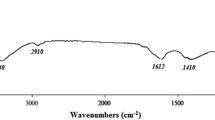Abstract
The inhibitory effects of seven microalgae, Nostoc flagelliforme, Spirulina platensis, Porphyridium purpureum, Rhodosorus marinus,Chlorella pyrenoidosa, Dunaliella salina and Pleurochrysiscarterae on the activation of hyaluronidase were evaluated. Theinhibitory effect of the ethanol-insoluble fraction of each water extract frommicroalgae was stronger than that of the ethanol-soluble fraction. The50% inhibitory concentration (IC50) of the ethanol-insolublefraction of S. platensis, P. purpureum, R. marinus, C.pyrenoidosa, D. salina and P. carterae was 0.15, 0.18, 0.26,0.94, 0.15 and 0.41 mg mL-1, respectively. The IC50 ofN .flagelliforme was not calculated, because there was no detectableinhibitory effect of this alga. The IC50 of disodium cromoglycate(DSCG) used as the anti-allergic medicine was 0.14 mg mL-1. The IC50 of S. platensis, P. purpureum and D. salinawere almost the same as that of DSCG. This suggests that theethanol-insoluble fraction of S. platensis, P. purpureum and D. salina might be an anti-allergic substance. The ethanol-insoluble fractionof S. platensis and D. salina was ultrafiltered through a membranehaving a molecular exclusion limit of 20 kDa. The IC50 of theresidue was stronger than that of the filtrate. These results suggest that theanti-allergic substance(s) of these microalgae may be polysaccharides.
Similar content being viewed by others
References
Chambers R, Zweifach WB (1947) Intercellular cement and capillary permeability. Physiol. Rev. 27: 436-463.
Coombs RRA, Gell PGH (1963) Clinical Aspects Immunology. F.A. Days Company, Philadelphia, pp. 317.
Duran-Reynals F (1939) A general permeability-increasing effect of a factor from mammalian testicle on blood capillaries. Yale. J. biol. Med. 11: 601-612.
Goggins FJ, Fullmer HM, Steffik AJ, Steffek JA (1968) Hyaluronidase activity of human gingiva. Arch. Path. 85: 272-274.
Ishizaka T, Ishizaka K (1975) Biology of immunoglobulin E. Molecular basis of reaginic hypersensitivity. Progr. Allergy 19: 60-121.
Ishizaka T, Chang TH, Taggart M, Ishizaka K (1977) Histamine release from rat mast cells by antibodies against rat basophilic leukemia cell membrane. J. Immunol. 119: 1589-1596.
Ishizaka T, Ishizaka K (1978) Triggering of histamine release from rat mast cells by divalent antibodies against IgE-receptors. J. Immunol. 120: 800-805.
Ishizaka T, Foreman JC, Sterk AR, Ishizaka K (1979) Induction of calcium flux across the rat mast cell membrane by bridging IgE receptors. Proc. Natl. Acad. Sci. USA 76: 5858-5862.
Kakegawa H, Mitsuo N, Matsumoto H, Satoh T, Akagi M, Tasaka K (1983) Hyaluronidase-inhibitory and anti-allergic activities of the photo-irradiated products of tranilast. Chem. Pharm. Bull. 33: 3738-3744.
Kakegawa H, Momoi Y, Tada K, Mitsuo N, Matsumoto H, Taira Z, Endo K, Satoh T, Terada H (1984) Studies on methodology of finding the anti-allergic agent with the guidance of anti-hyaluronidase activity. J. Pharm. Dyn. 7: s-96.
Kakegawa H, Matsumoto H, Satoh T (1985) Activation of hyaluronidase by metallic salts and compound 48/80, and inhibitory effect of anti-allergic agents on Hyaluronidase. Chem. Pharm. Bull. 33: 642-646.
Kanno T, Sinpo K, Masada M, Tamura G (1996) Growth-promoting factor for yeast from an extract of Chlorella vulgris CK-5: 74, 159-162.
Maeda Y, Yamamoto M, Masui T, Nakagai K (1987) Inhibitory effect of anti-inflammatory agents, anti-allergic agents and dried extracts of Chinese medical preparation on hyaluronidase. Bull. Shizuoka Pref. Inst. Publ. Hlth. and Environ. Sci. 30: 41-45.
Maeda Y, Yamamoto M, Masui T, Sugiyama K, Yokota M, Nakagomi K, Tanaka H, Takahashi T, Kobayashi E (1990) Inhibitory effect of tea extracts on hyaluronidase. Shokuhin Eiseigaku Zashi 31: 233-237.
Maeda Y, Yamamoto M, Masui T (1991) Anti-allergic effect of citrus fruit using the inhibitory effect on the activation of inactive hyaluronidase as an index. Bull. Shizuoka. Pref. Inst. Publ. Hlth. and Environ. Sci. 34: 19-23.
Rovelstad GH, Geller HJ, Cohen AH (1958) The hyaluronidase activity of saliva. J. Dent. Res. 33: 114-118.
Sawabe, Y., Iwagami, S., Maeda, Y., Nakagomi, K., Suzuki, S., Nagazawa, H. (1990) Studies on hyaluronidase inhibitor of Gymnema sylvestre R. Br. Eisei. Kagaku 36: 314-319.
Takenaka H (1996) What's Micro Algae? Shiki Press, Tokyo, pp. 38.
Yang HN, Lee EH, Kim HM (1977) Spirulina platensis inhibits anaphylatic reaction. Life Sciences 61: 1237-1244.
Author information
Authors and Affiliations
Rights and permissions
About this article
Cite this article
Fujitani, N., Sakaki, S., Yamaguchi, Y. et al. Inhibitory effects of microalgae on the activation of hyaluronidase. Journal of Applied Phycology 13, 489–492 (2001). https://doi.org/10.1023/A:1012592620347
Issue Date:
DOI: https://doi.org/10.1023/A:1012592620347




